Gobi Gosht (Goat/Lamb and Cauliflower curry)
Gobi Gosht is a classic Pakistani dish of tender meat and flavorful cauliflower. This is a dump-and-go recipe that’s also remarkable in flavor. Make it in one pot with goat, lamb, or beef. Tested to perfection!
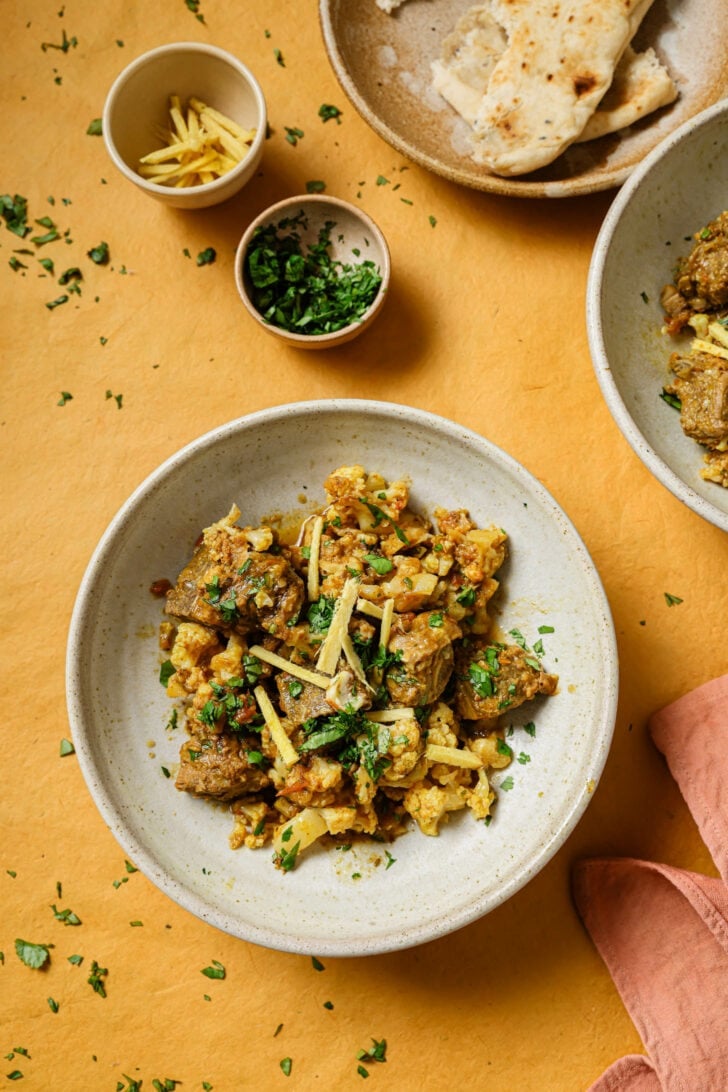
Want to save this post?
Enter your email below and get it sent straight to your inbox. Plus, get recipes & tips every week!
Gobi Gosht
Roots are woven into our identity. It’s pointless to deny them. You’ll find them if you look: in your food preferences, in your clockwork cravings for chai, in your familiarity with something as innocuous as Gobi Gosht.
I find it’s better to honor our roots, to look at what they teach us, and what we wouldn’t have seen otherwise. Honoring them is not to be tied down by them, but to own them while moving forward.
In this case, it’s Gobi Gosht settled into modern crockery on retro yellow and terracotta. The cauliflower cooked well past what any Michelin-starred chef would approve, because that’s just how we like it. It’s a tested-and-perfected, working recipe for Gobi Gosht – a dish that’s all but gone from the Pakistani diaspora food scene, but still a part of many of us.
More Goat/Lamb Recipes: Mutton Pulao, Aloo Gosht, IP Goat Curry with Bell Peppers
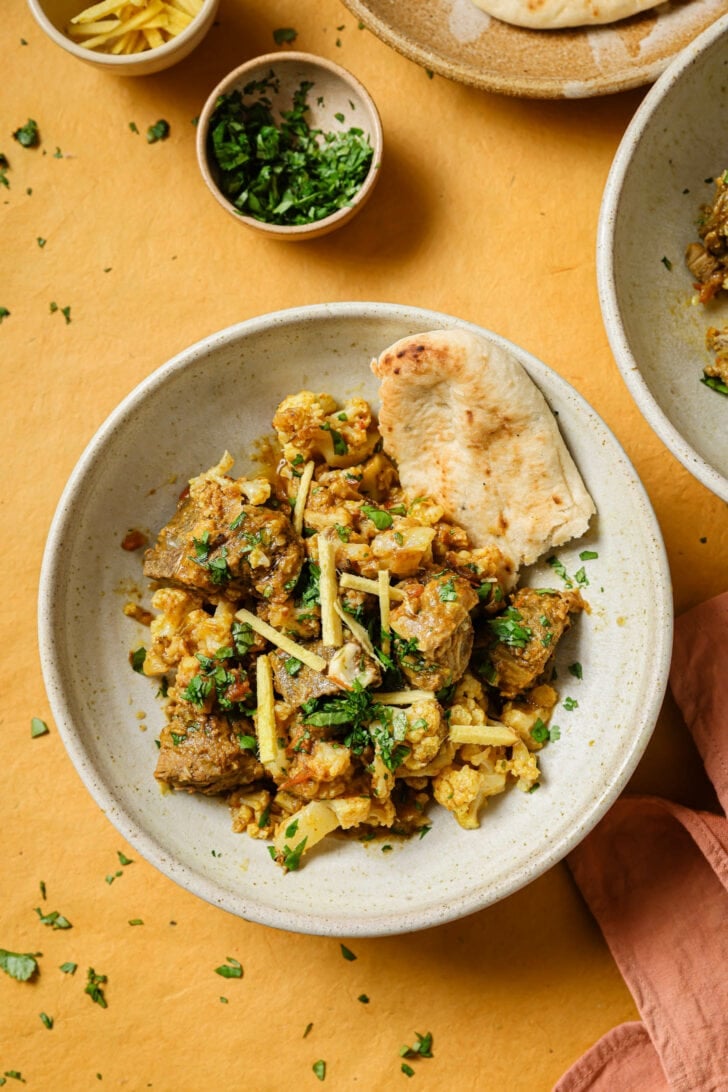
What You’ll Love About this Recipe
- It’s a Dump-and-Go recipe. No browning onions – just a good bhunai (sauté) once you’ve cooked the meat.
- Though it takes time to cook the meat, it’s largely hands-off.
- You can use goat meat (what I use), lamb meat (more popular in the West), or even beef (see Variations).
- It includes Instant Pot instructions for cooking the meat, then transferring to stovetop.
- It’s immensely tasty. In the words of my recipe tester, “it’s close to (I’d say better than) my mother’s/grandmother’s”.
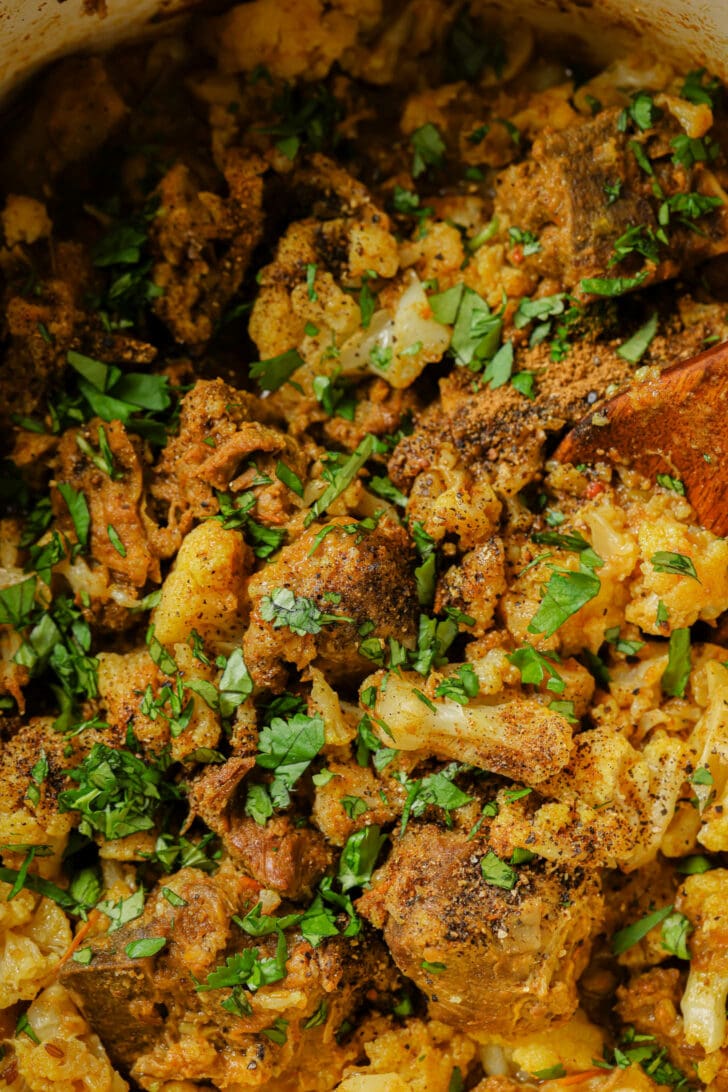
Ingredients
Cauliflower
I like a good amount of cauliflower in my Gobi Gosht, but you can vary the ratio of meat to cauliflower as you’d like. I usually chop the cauliflower while my meat is cooking, toward the end. Here’s how to cut the florets:
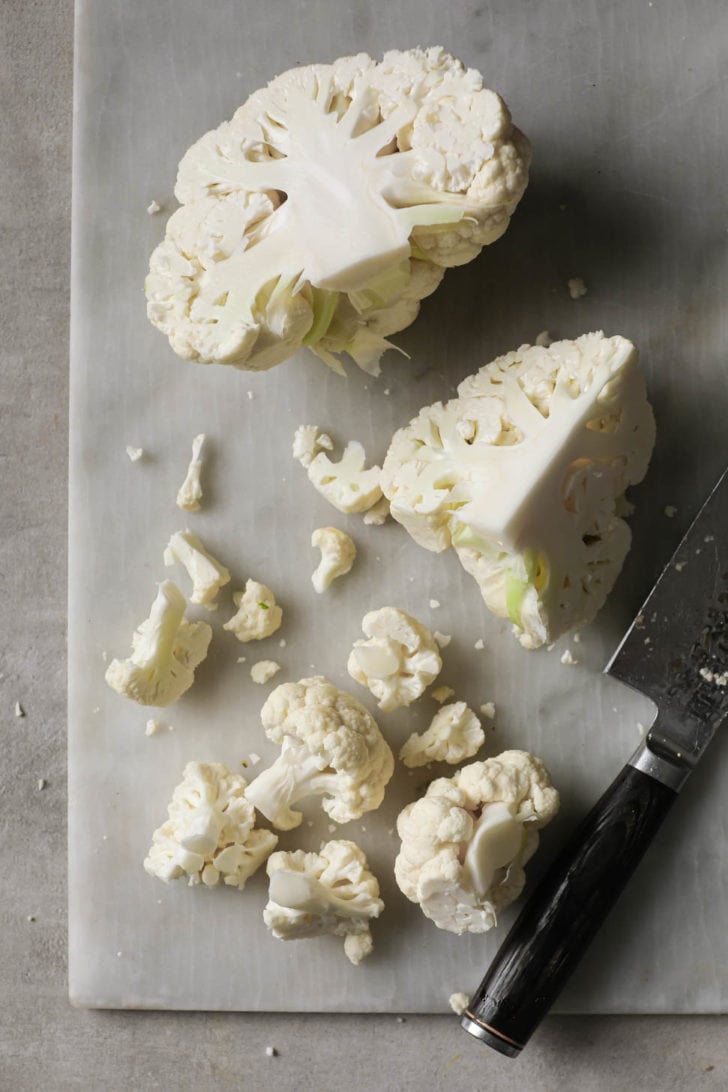
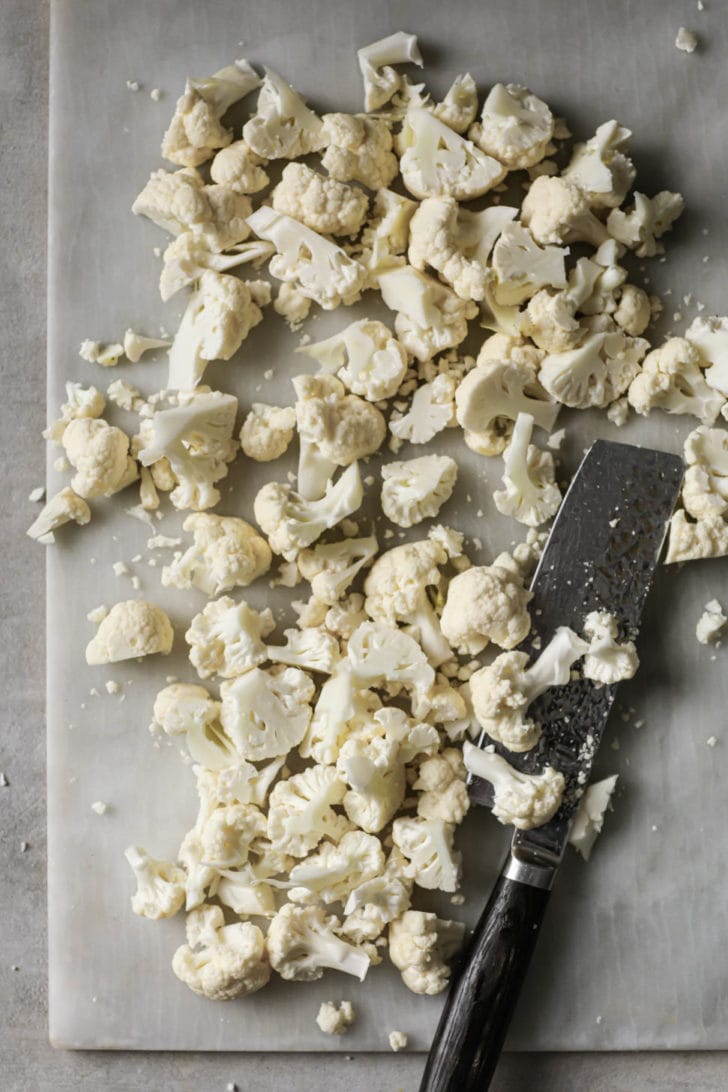
For more visual guidance, here’s a video showing how to cut cauliflower similar to how I’ve just described.
Notes on Other Key Ingredients
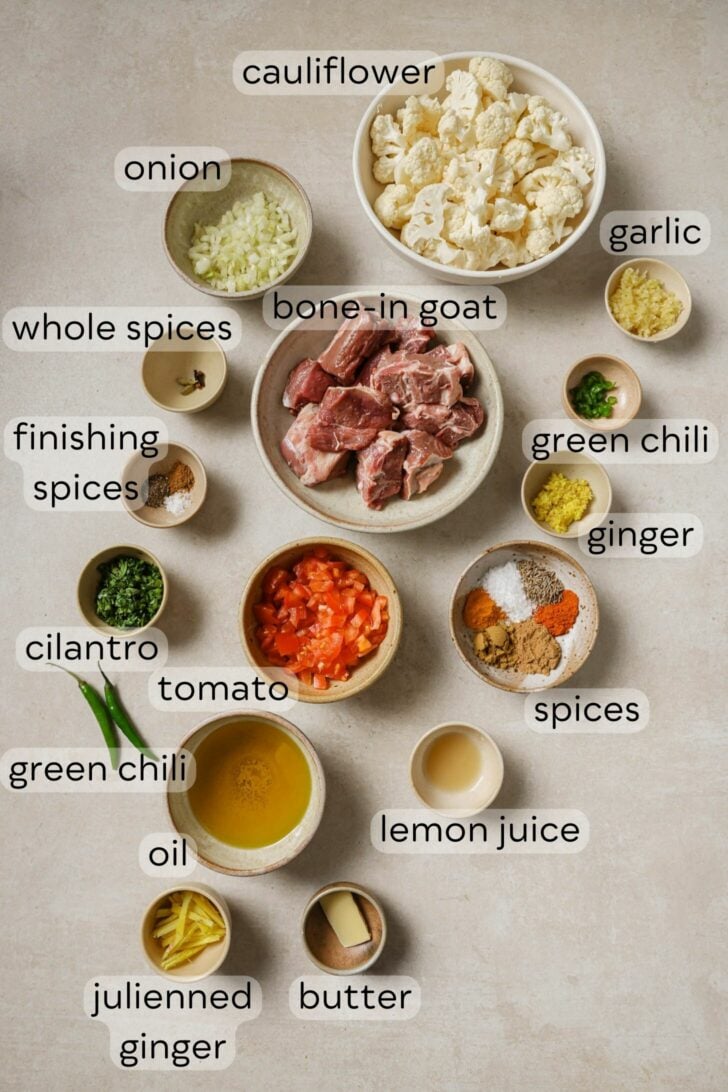
- Bone-in Goat or Lamb: Traditionally, Gobi Gosht is made with bone-in goat or lamb cut up into around 1.5-2″ pieces. Goat is especially hard to find at most supermarkets, but you can easily find it at Halal meat markets.
- I usually use the ‘mixed’ cut made from various parts. If you prefer meatier pieces, go for leg or shoulder. See variations for replacing goat/lamb with beef.
- Vine or Roma tomatoes: Ripe, tasty ones for make a big difference in flavor. If yours are particularly tasteless, you may want to add yogurt for the tangy flavor.
- Green chili pepper: Such as Serrano or Bird’s Eye. For subtle heat and flavor when cooking the goat. Afterward, I like to add another green chili along with the cauliflower, this time for aroma and aesthetics.
- Spices: A few whole spices to add depth – cumin seeds, cloves, and green cardamom pods. You’ll also need standard ground spices such as coriander powder, cumin powder, red chili powder, and turmeric.
- Finishing ingredients: Garnishing ingredients really elevate Gobi Gosht. Freshly ground black pepper, garam masala, cilantro, lemon, and a bit of julienned ginger. You don’t need the julienned ginger but it looks nice. As my mother-in-law says, wherever there’s cauliflower, add extra ginger.
- Butter: Not essential but just to take it over the top.
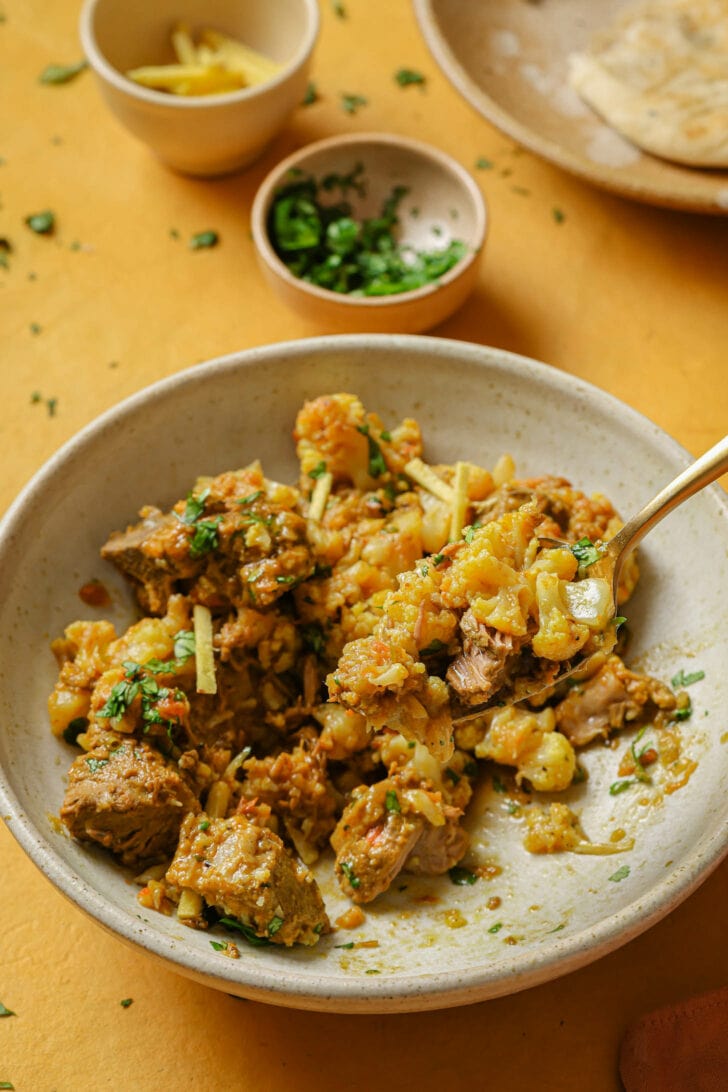
How to make Gobi Gosht
This recipe takes time, but it’s straightforward. Here’s what you’ll do:
Cook the Meat
- Combine the ingredients listed under ‘To Cook the Meat’ into a large Dutch oven or heavy-bottomed pot. You don’t need too much water here because you’ll be sautéing it down after the meat cooks. Cover and simmer over low heat to help get the meat nice and tender. It takes my meat around 1hr and 30 minutes.
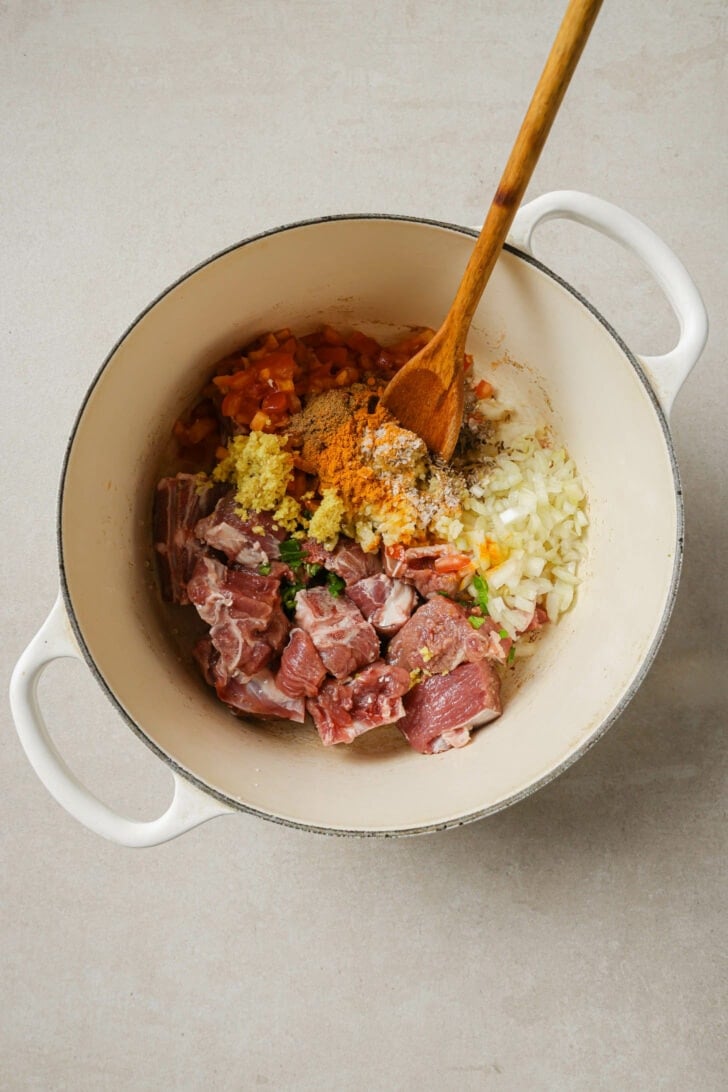
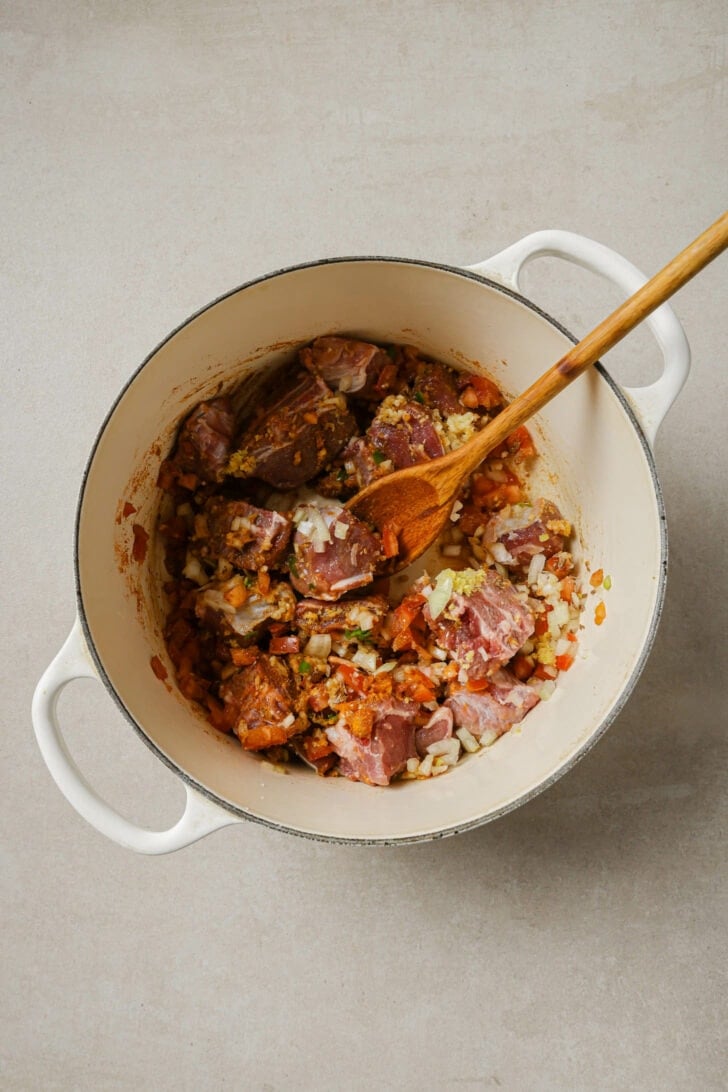
Tip: Do not proceed to the next step if your meat isn’t fully tender. You want it to break when pressed with a wooden spoon. If not, continue to cook for another 10-15 minutes.
Sauté out Moisture
- Increase the heat to high and sauté out the remaining water content/moisture. Now that the meat is cooked, we’ll reduce the masala down, concentrating all the flavors and getting it ready to cook it in oil.
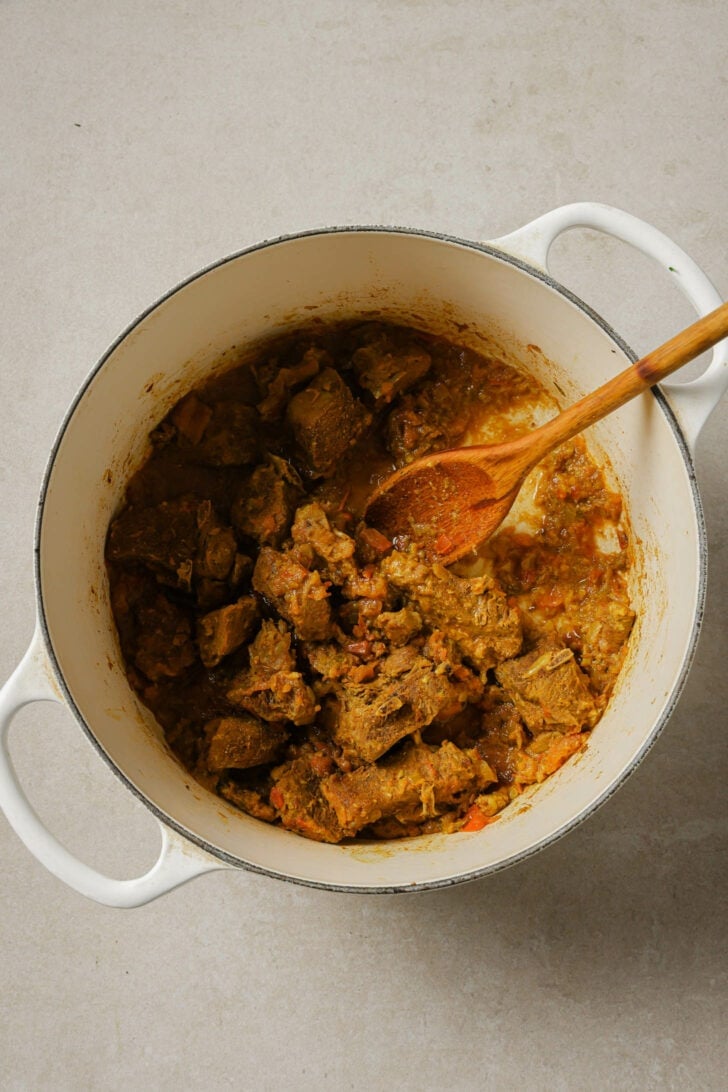
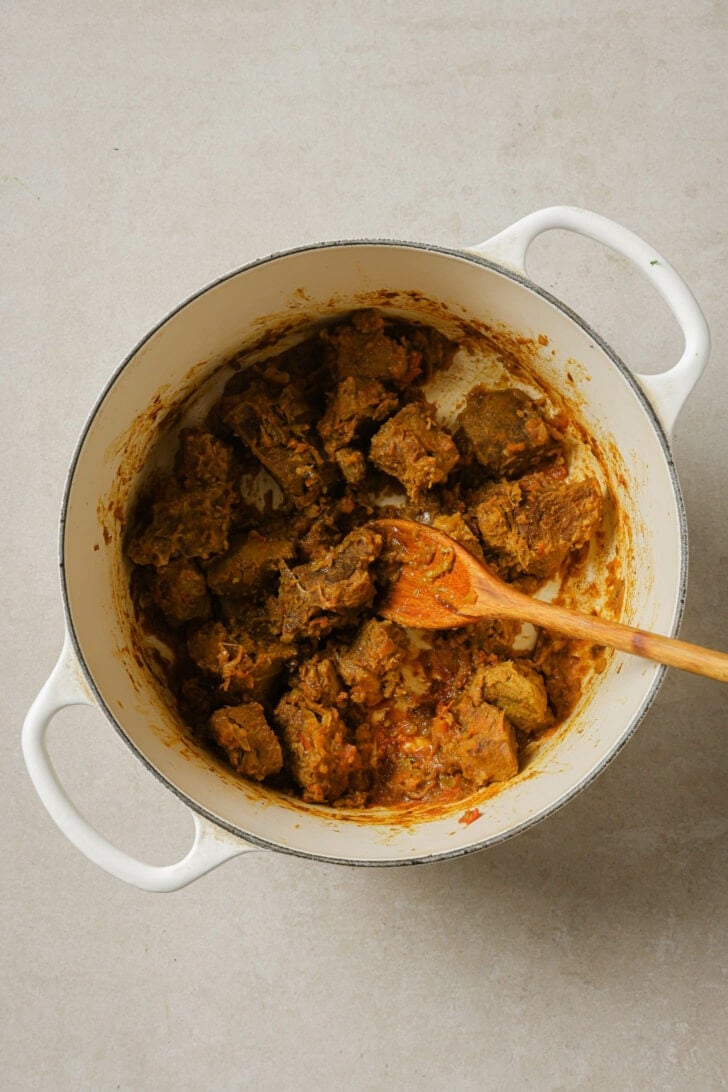
Sear the Meat
- Once the water has evaporated, add the oil and continue to sauté (bhunai) for another 5-6 minutes. The idea here is to brown the meat and give it flavor while removing any hint of rawness, or kachapan from the oil. Deglaze any bits stuck on the pan with 1-2 tbsp of water.
Bhunai: Bhunai is a term used to describe an important South Asian cooking technique. This technique, which can best be described as a blend of sautéing and frying, is critical to ‘cook out’ each component of a curry and maximize its flavors. Here, we’re using bhunai to reduce the onions and tomatoes into a homogenous, cohesive masala while giving the meat intense flavor (maillard reaction). Taking the time to cook it down here is why we don’t have to initially brown the onions.
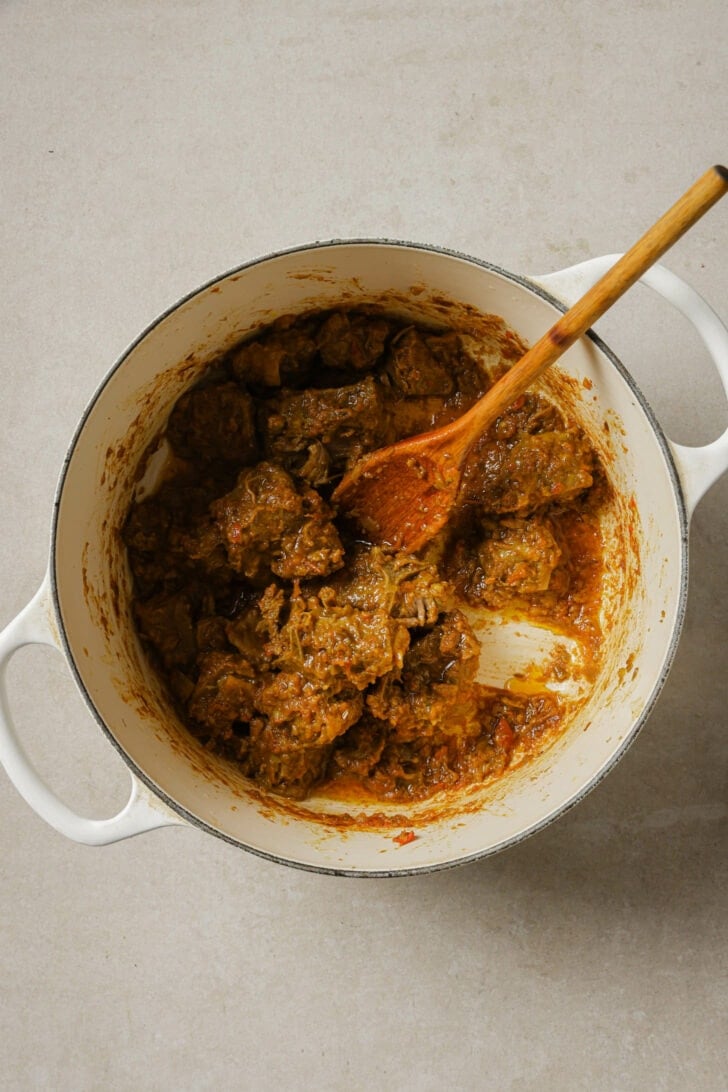
Steam the Cauliflower
- Drain the cauliflower and add it along with the green chili pepper and salt. Steam over low heat until the cauliflower is very tender. No need to add any water, the cauliflower will release its own moisture. Stir once or twice in between to prevent sticking.
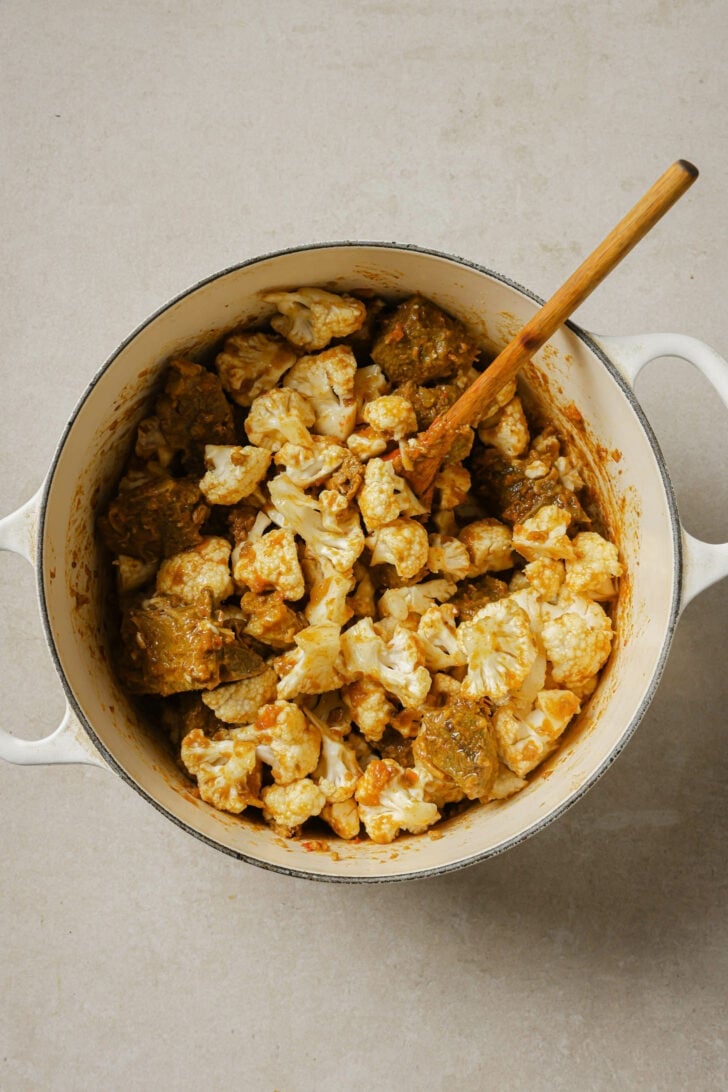
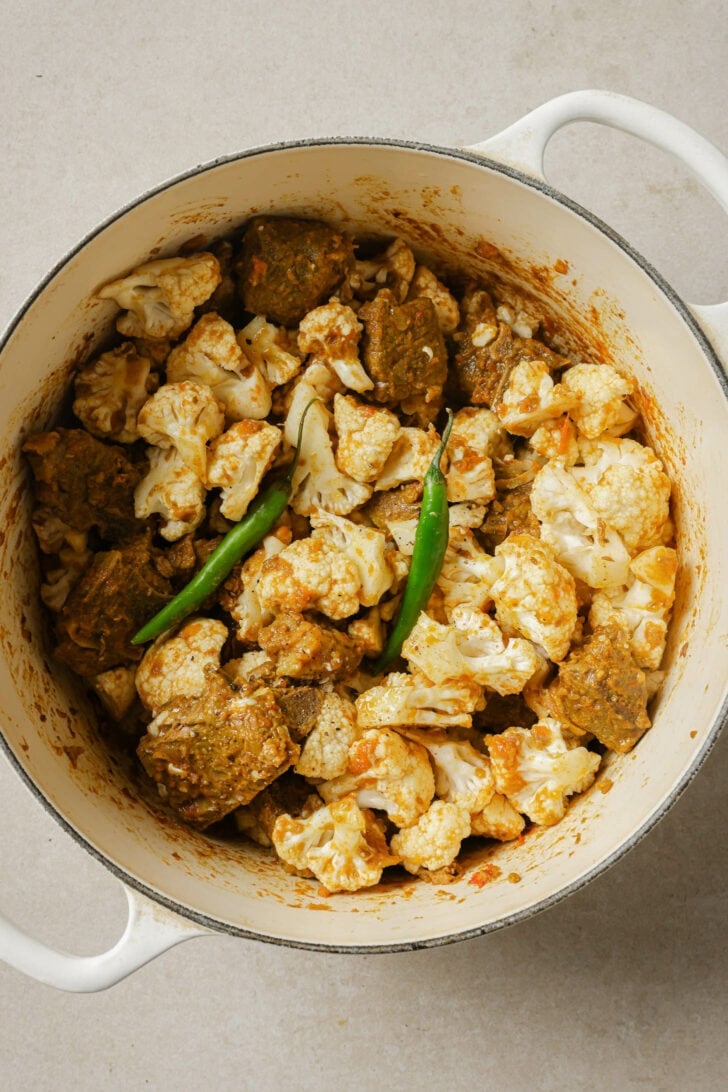
Garnish
- Uncover and stir. Taste and adjust salt, if needed. If there is some moisture or curry remaining, increase the heat to medium-high and sauté gently, being careful not to break the meat. Once the oil starts to leave the sides, turn the heat to the lowest setting.
- While the curry is simmering gently over low heat, garnish with black pepper, garam masala, cilantro, and lemon. If you’d like, right before serving, top with julienned ginger and a pat of butter.
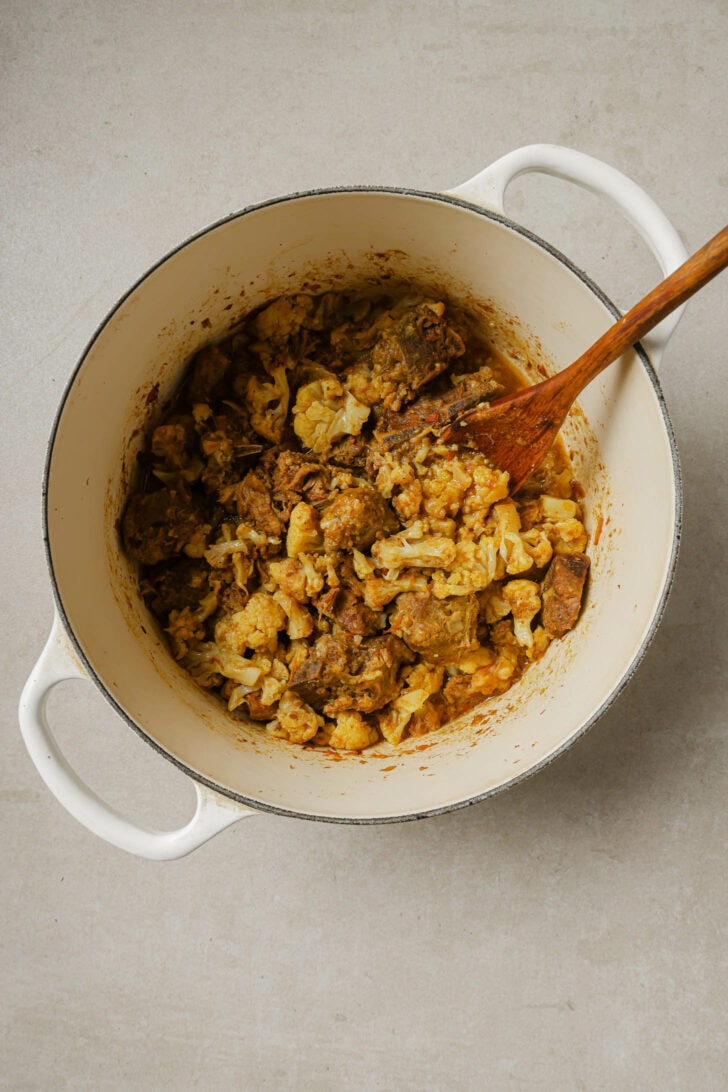
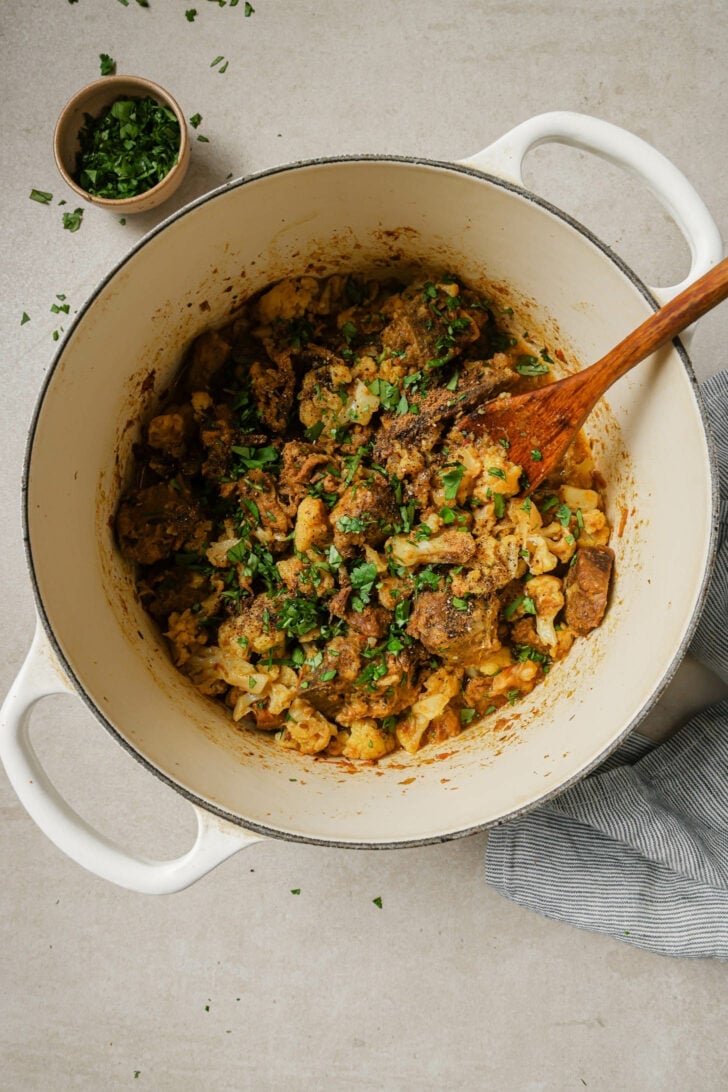
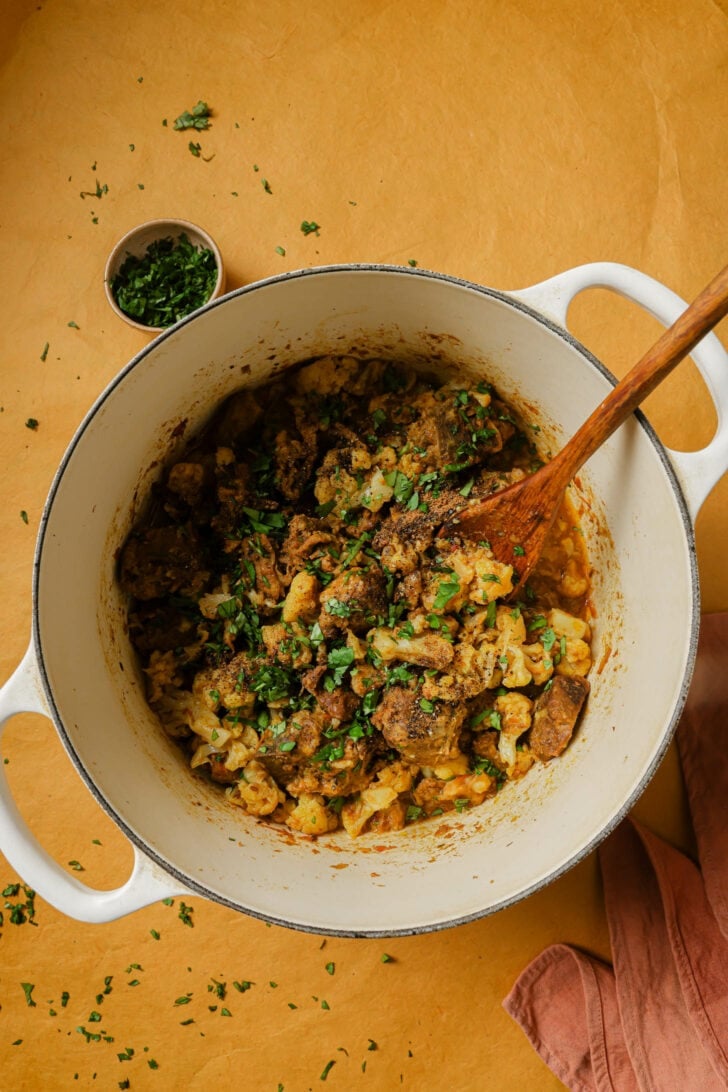
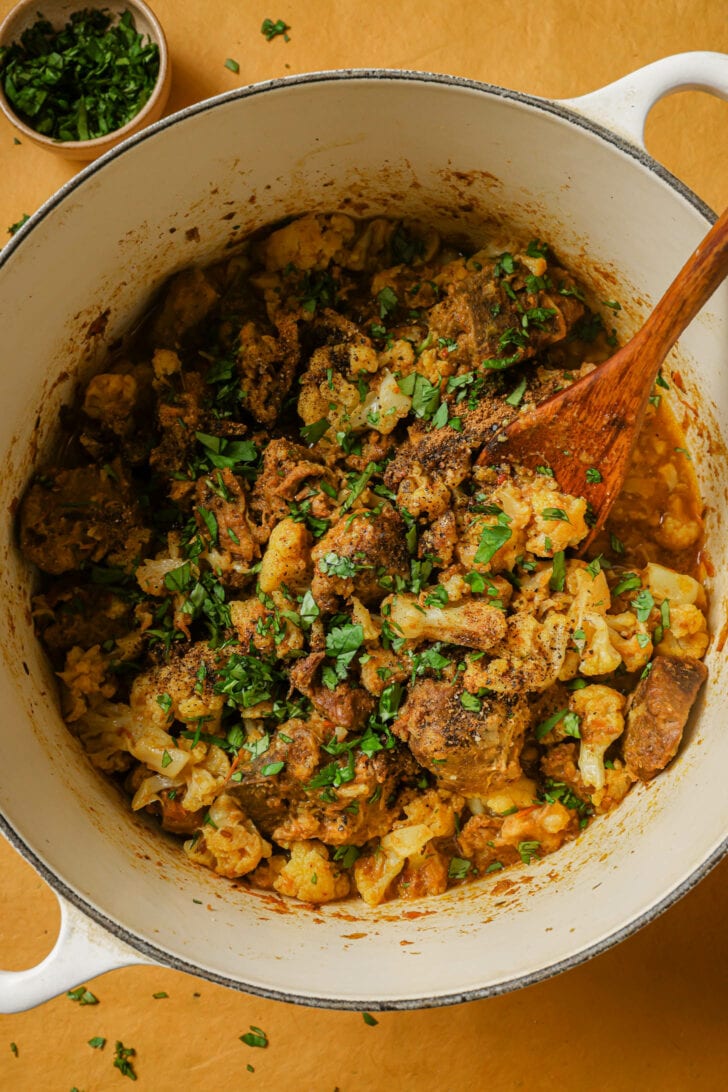
Variations
How to add more Curry
If you prefer the version with a light curry, like Aloo Gosht, just add 1/2-1 cup water along with the cauliflower in Step 5.
How to Replace Goat/Lamb with Beef
To make this with beef, cube the beef into 1″ chunks and increase cooking time. Because beef stew is a tougher meat, it takes longer to cook (~3-4 hours). Keep topping with water as needed until it breaks easily when pressed with a wooden spoon. See FAQ for a handy meat cooking time table.
Instant Pot Method
I’ve tried many times to make this entirely in the Instant Pot. Unless you want the extra gravy version, it’s hard to steam the cauliflower in the Instant Pot. It gets watery and mushy instead of tender. If you pressure cook it again, it sticks. (If you’re able to make it entirely in the IP, I’d love to hear from you.) It’s less of a circus act if you cook the meat in the Instant Pot, then transfer it to stovetop. I’ve included the instructions in the recipe card.
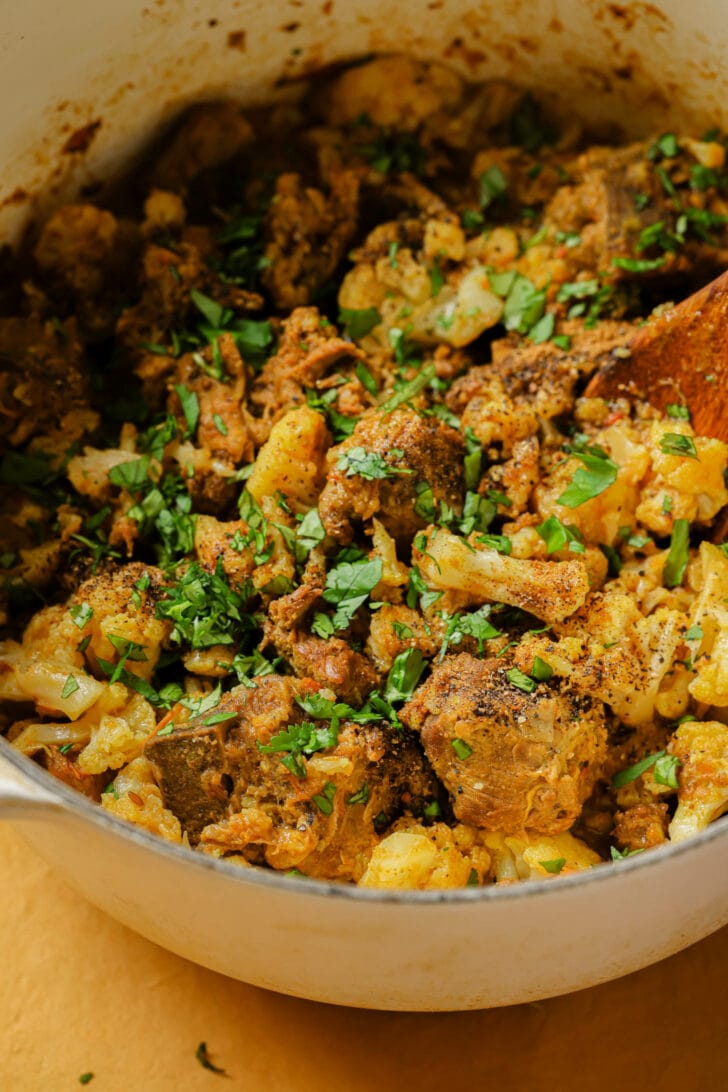
Tried this recipe? If you have a minute, please consider leaving a comment telling me how it was! If you have a photo of your dish, please feel free to upload it and share with others. If you’re on Instagram, please tag me so I can see your creations. I truly love hearing from you. Thank you!
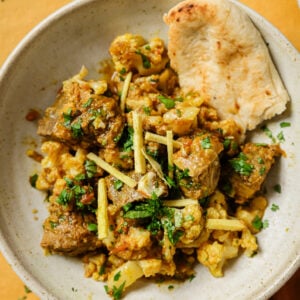
Gobi Gosht (Goat/Lamb and Cauliflower Curry)
Watch the Video
Ingredients
To Cook the Meat:
- 1.25 lb (~567 g) bone-in goat or lamb meat (mixed pieces – See Note 1), cut up into ~2" pieces, cleaned and excess fat removed
- 6 garlic cloves, crushed or finely chopped
- 1 1/4 inch ginger, crushed or finely chopped
- 1 medium (~250 g) yellow onion, finely chopped
- 2 small (~200 g) ripe tomatoes (I use Vine or Roma), finely chopped
- 1/2 Serrano pepper or 1 Thai/bird's eye green chili pepper, roughly chopped
- 1 tsp cumin seeds
- 2 green cardamom pods
- 2 whole cloves
- 1 1/2 tsp coriander powder
- 1 tsp cumin powder
- 3/4 tsp red chili pepper, or cayenne
- 1/2 tsp turmeric powder
- 1 3/4 tsp kosher salt
After Cooking the Meat:
- 1/3 cup neutral oil
- 1 small (~660 g) head cauliflower, measured after chopping
- 1-2 small Serrano or Thai green chili peppers, cut in half or left whole – optional
- 1/4 tsp kosher salt
- 1/2-3/4 tsp freshly ground black pepper
- 1/4 tsp garam masala
- 3 tbsp cilantro leaves, finely chopped
- 1 tsp freshly squeezed lemon juice
- julienned ginger, optional – for garnish
- pat of butter, optional – for topping
Equipment
- Heavy bottomed pot or Dutch Oven
Instructions
- Place all ingredients listed under ‘To Cook the Meat’ into a large, heavy-bottomed Dutch oven. Mix to combine. Add ½ cup water (the less the better because this will be sautéed out) so that the water covers at least ⅓ of the meat.
- Turn the stovetop on to high heat. Cover to allow the mixture to come to a gentle boil. Once it comes to a boil, reduce the heat to a gentle simmer (low or low-medium). Cover and cook for 1 hour & 30 minutes, until the meat is fully cooked but not fall-off-the-bone tender. The meat should break when pressed with a wooden spoon. If not, cover and allow to cook for another 15-30 minutes, topping with water if needed.
- Meanwhile, chop the cauliflower. Remove the leaves and hard bottom stem. Then cut the cauliflower into quarters. Use your knife to cut out the core from each quarter. Cut tough stems of florets into thin strips. Cut the florets into 1” pieces. If you have a large floret, cut it in half. Rinse the thin strips and florets under running water. Then place in a bowl and soak in water while you wait for the meat to finish cooking.
- Increase the heat to high and stir occasionally to sauté out the remaining water content/moisture (~7-10 minutes). Once the water has completely evaporated, add oil and continue to sauté (bhunai) for another 5-6 minutes. The idea here is to sear the meat and give it flavor while removing any hint of ‘raw’ flavor from the oil. Deglaze any bits stuck on the pan with 1-2 tbsp of water.
- Drain the cauliflower and add it along with the green chili pepper (if using) and salt. Toss to coat the cauliflower in the masala.
- Reduce the heat to low. Cover and allow to steam for 25 minutes, until the cauliflower is very tender. (No need to add any water, the cauliflower will release its own moisture.)
- Uncover and stir. Taste and adjust salt, if needed. If there is some moisture or curry remaining, increase the heat to medium-high and sauté gently, being careful not to break the meat. Once the oil starts to leave the sides, turn the heat to the lowest setting.
- While the curry is simmering gently over low heat, garnish with black pepper, garam masala, cilantro, and lemon. If you’d like, right before serving, top with julienned ginger and a pat of butter. Serve immediately with roti, paratha, naan, or your choice of bread.
Notes
- Place all ingredients listed under to ‘To Cook the Meat’ into the instant pot. Mix to combine. (No need to add any water.)
- Select ‘Pressure Cook – High’ and set the timer for 18 minutes, even for goat leg/shoulder cuts. NPR for 5 minutes, then manually release remaining pressure.
- Heat a large pan on the stovetop over high heat. Carefully transfer IP contents to the pan. Stir occasionally to reduce/sauté out most of the water content/moisture (~20 minutes). This takes patience, but adding cauliflower before sautéing out water will give you even more moisture to sauté out. Once the water has evaporated, add the oil and proceed with Step 4.


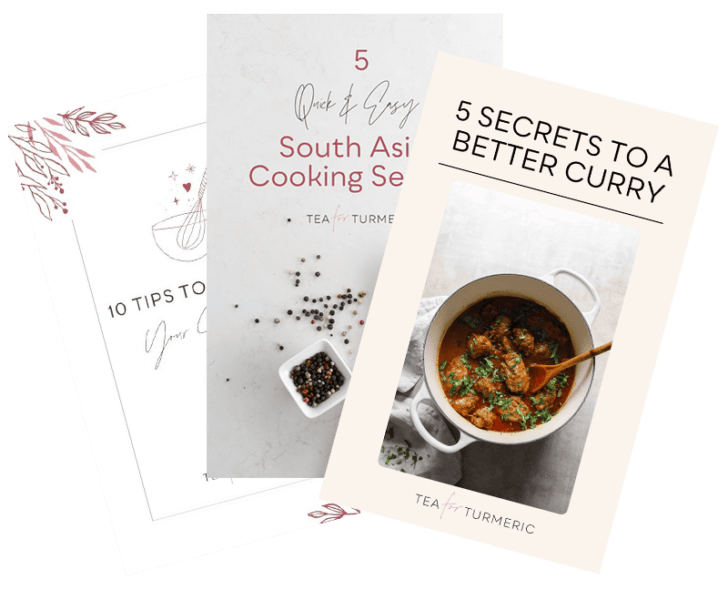
4 Comments on “Gobi Gosht (Goat/Lamb and Cauliflower curry)”
I made this tonight for dinner and it was delicious! A huge hit with my husband and kids 🙂
Hi Kholla, That’s great to hear! Thank you for sharing 🙂
Izza, make it without onions and tomatoes. Saute the meat in oil with spices, when meat is cooked, throw in the gobhi. You need the onions and tomatoes for curries and “shorba”. But when you have something like gobhi and palak, no need for onions and tomatoes. Try it, you’ll be surprised 🙂
Ooh so kind of like a roasted Gobi Gosht. I’ll have to try that sometime! Thank you for sharing, Samina!